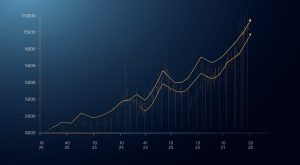Gold and Its Powerful Potential at the End of 2025
As global markets navigate inflationary pressures, geopolitical uncertainty, and shifting monetary policies, one asset continues to command investor attention: gold.
While 2024 saw renewed enthusiasm for technology stocks and digital assets, the landscape heading into late 2025 paints a different picture. Central banks are rethinking rate policies, emerging markets are stockpiling bullion, and investors are once again turning to gold — not just as a defensive hedge but as a strategic growth asset.
In this in-depth report, we’ll explore why gold’s powerful potential may shine brightest at the end of 2025 — and how smart investors are preparing for what could be one of the most significant commodity uptrends of the decade.
Gold’s Enduring Role in a Changing Economy
Gold has been a cornerstone of wealth preservation for centuries. Its role evolves with each market cycle, but its core function remains the same — a store of value in times of uncertainty.
As the global economy transitions out of the post-pandemic recovery phase, several macroeconomic forces are converging to create a near-perfect setup for gold’s resurgence:
-
Slowing Economic Growth — The IMF projects modest GDP expansion in 2025, particularly across developed markets.
-
Central Bank Accumulation — Central banks have been net buyers of gold for over 12 consecutive quarters, led by China, India, and Russia.
-
Monetary Shifts — The anticipated start of rate cuts by major central banks could weaken the U.S. dollar and enhance gold’s appeal.
-
Rising Debt and Fiscal Deficits — Record government borrowing increases inflationary risks and investor anxiety.
These dynamics position gold as not just a safe haven — but a strategic outperformer in a late-cycle market environment.
The 2025 Economic Backdrop: Why Gold Stands Out
As of mid-2025, the global economic outlook reflects both opportunity and fragility. Inflation has moderated from its 2023 highs, yet remains above target in most advanced economies. Central banks are under pressure to balance price stability with growth support.
1. The Fed’s Policy Pivot
Market consensus suggests the Federal Reserve could begin rate reductions by Q4 2025. Historically, gold prices tend to rise as interest rates fall, since lower yields reduce the opportunity cost of holding non-yielding assets.
2. The Dollar’s Deceleration
A softening dollar often fuels gold rallies. As the greenback loses strength against emerging-market currencies and the euro, international investors view gold as a stable alternative store of value.
3. Persistent Geopolitical Tensions
Conflict zones in Eastern Europe, trade friction between the U.S. and China, and instability in energy markets contribute to a risk-off sentiment. Gold thrives during such periods as capital rotates out of equities and into tangible assets.
According to Chronostual.com, “Gold’s late-2025 outlook reflects a convergence of macro drivers unseen since 2011 — falling real rates, currency weakness, and demand diversification from central banks.”
Central Banks: The Silent Gold Buyers Driving the Market
Behind the headlines, central bank demand has become one of the most important — and underappreciated — drivers of the gold market.
In 2024, global central banks purchased over 1,000 metric tons of gold, marking one of the highest annual totals in modern history. This trend is expected to persist into 2025 and beyond, signaling growing mistrust in the long-term stability of fiat currencies.
Why Central Banks Are Buying
-
De-dollarization Strategy: Emerging economies are diversifying reserves away from the U.S. dollar.
-
Inflation Hedge: Gold provides insurance against global monetary instability.
-
Reserve Security: Unlike bonds, gold carries no counterparty risk.
A detailed analysis from Zoopora.com notes that “institutional demand for physical bullion has become a stealth force behind the market — insulating prices from speculative downturns and providing a floor for long-term valuation.”
This sustained accumulation hints at what could become a multi-year structural bull market.
Investor Behavior: A Rotation Toward Tangible Assets
After years of speculative enthusiasm for equities and crypto, 2025 is witnessing a quiet rotation back to real assets. Commodities, real estate, and especially precious metals are regaining traction as investors seek stability amid volatile macro conditions.
Why Investors Are Returning to Gold
-
Diversification: Gold historically shows low correlation with equities and bonds.
-
Inflation Protection: While inflation may ease, it remains higher than pre-2020 levels.
-
Safe-Haven Demand: In uncertain political or financial climates, gold becomes a preferred store of value.
-
Portfolio Insurance: Even a 5–10% allocation to gold can materially reduce volatility.
This is not mere speculation — fund flows back it up. Gold ETFs have seen net inflows in six of the past eight months, and several new institutional-grade gold funds launched in Q3 2025.
Technological Demand: The Hidden Catalyst
Beyond jewelry and investment, industrial and technological uses for gold are increasing. As electronics, EVs, and AI infrastructure expand, gold’s conductivity and resistance properties are driving new forms of demand.
Applications in semiconductors, nanotechnology, and green-energy manufacturing may not replace investment-driven demand, but they add a steady layer of consumption that supports long-term price resilience.
Price Outlook: Where Gold Could Be Headed
Analysts remain divided on just how high gold could go, but consensus is clearly bullish.
Key Forecasts for Late 2025
-
Goldman Sachs: $2,650/oz by Q4 2025
-
UBS: $2,500/oz, citing rate cuts and emerging-market demand
-
JPMorgan: $2,700/oz “in a late-cycle rally similar to 2011”
Even conservative estimates suggest that gold could deliver double-digit returns relative to 2024 levels — outperforming most equity indexes in a late-cycle environment.
Gold vs. Competing Safe Havens
1. Gold vs. Treasury Bonds
U.S. Treasuries have long been the standard for safety, but as yields decline, their real return diminishes. Gold, by contrast, benefits from falling yields — turning what’s bad for bonds into a catalyst for its own rally.
2. Gold vs. Crypto
Crypto assets like Bitcoin often claim to be “digital gold,” but their volatility and regulatory scrutiny remain obstacles to institutional adoption. Traditional gold still dominates as a tested, liquid, and globally recognized store of value.
3. Gold vs. Real Estate
While property values remain stable, the illiquidity and high transaction costs of real estate make gold a more flexible store of value — particularly for cross-border investors.
The Role of ETFs and Digital Gold
Exchange-traded funds (ETFs) and tokenized gold platforms are transforming how investors access gold.
-
Gold ETFs: Offer quick exposure without physical custody hassles.
-
Tokenized Gold: Blockchain-backed platforms now allow fractional ownership of vaulted bullion, merging digital convenience with tangible value.
As noted in a FinanceWorldHub.com report, “the hybridization of gold investment — combining physical assurance with digital liquidity — could define the next decade of commodity innovation.”
This integration of traditional and digital systems enhances gold’s accessibility, particularly for younger investors.
Risks to Watch
Despite the bullish case, gold investors should stay aware of potential headwinds:
-
Stronger-than-expected Dollar: Could temporarily cap gains.
-
Faster Inflation Decline: May reduce safe-haven appeal.
-
Central Bank Sales: Unlikely, but could create short-term supply shocks.
-
Rising Real Rates: If inflation falls faster than nominal yields, gold could stall temporarily.
Still, given the current macro trajectory, most analysts consider these risks cyclical, not structural.
Conclusion: Gold’s Next Great Chapter
As 2025 draws to a close, gold is once again asserting its dominance in a turbulent world. With central banks diversifying reserves, inflation still hovering above targets, and interest-rate pivots looming, the stage is set for gold to reclaim its role as the world’s most powerful safe-haven asset.
For investors willing to look beyond short-term volatility, gold represents a blend of security, liquidity, and potential upside rarely found elsewhere.
In a world of digital currencies, leveraged markets, and shifting geopolitical realities, gold’s timeless appeal remains — perhaps more relevant now than ever.
Education Made Simple

Blue Chip Stocks in 2025: Resilience, Reliability, and Real Growth
Blue Chip Stocks in 2025 remain pillars of market stability and growth, offering investors security, dividends, and consistent long-term value.

Index Funds in 2025: The Timeless Strategy Thriving in a New Financial Era
Index Funds in 2025 remain a cornerstone of smart investing, balancing simplicity, diversification, and steady returns in a volatile market environment.

Natural Gas in 2025: Balancing Energy Demand and Sustainability
Natural Gas in 2025 plays a pivotal role in global energy transition, balancing affordability, sustainability, and reliability amid evolving markets.

Tokenization in 2025: Redefining Ownership in the Digital Economy
Tokenization in 2025 transforms how assets are owned, traded, and valued, bringing transparency and liquidity to global financial systems.

Earnings Season 2025: What Investors Should Watch for in a Shifting Market
Earnings Season 2025 reveals how corporate results are shaping market confidence, guiding investors through volatility and economic transition worldwide.

Dividend ETFs in 2025: Consistent Income for a Volatile Market
Dividend ETFs in 2025 offer stability and passive income amid market uncertainty, helping investors balance risk and long-term returns effectively.

Copper’s Comeback: Why the Red Metal Is Powering the Next Global Boom
Copper’s comeback in 2025 is reshaping global industries as the red metal fuels electric vehicles, green tech, and infrastructure growth worldwide.

Stablecoins in 2025: The Bridge Between Traditional Finance and Digital Trust
Stablecoins in 2025 are redefining trust between crypto and traditional finance, offering stability, faster payments, and global accessibility for investors.

October Stocks: Market Trends and Investment Insights
October Stocks provide a detailed view of market trends, sector performance, and investment opportunities for the month. Explore insights, analysis, and strategies for optimizing portfolios in October.












